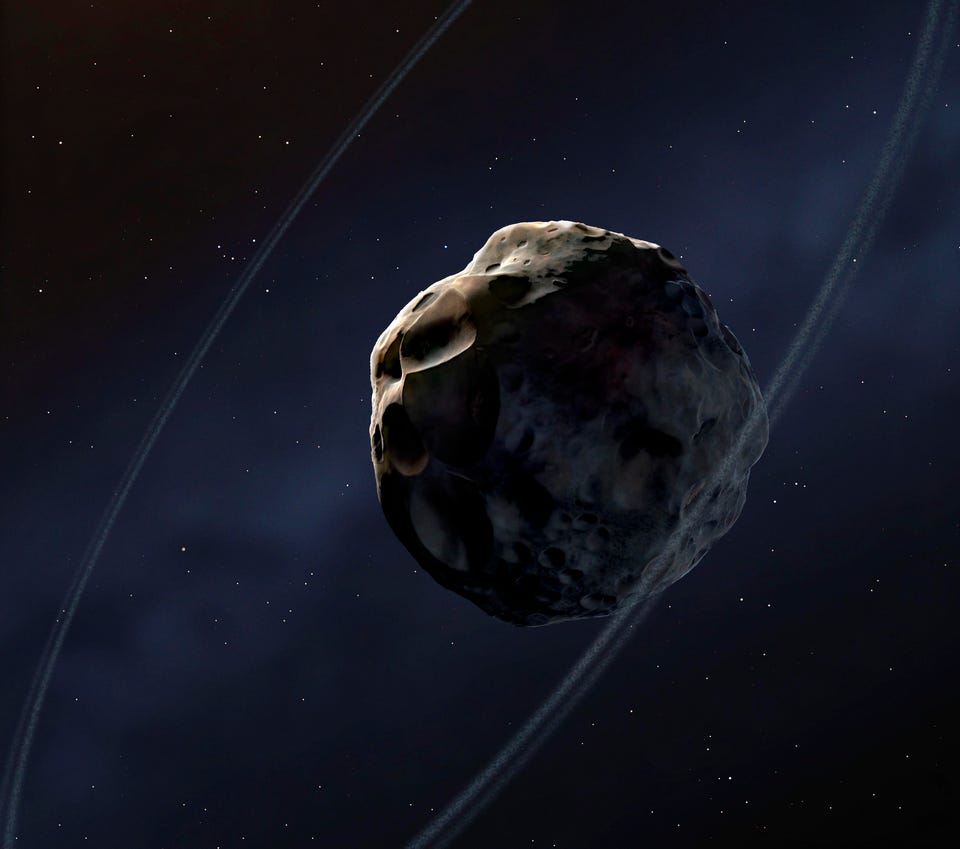Welcome To Chariklo, A Ringed World In The Solar System Just Examined By The Webb Telescope


Chariklo, discovered in 1997, is an asteroid of the Centaur variety, exhibiting characteristics of … [+] both asteroids and comets. It’s orbit takes it from 13 AU (astronomical units) to nearly 19 AU from the Sun. In March 2014, astronomers announced that Chariklo is encircled by a pair of narrow rings, making it the smallest known planetary body so decorated at only about 235 kilometres across. The innermost ring has a diameter of 792 kilometres and a width of 7 kilometres. The outermost ring is 810 kilometres across and narrower, with a width of 3 kilometres. They are separated by a 9 km gap and appear to be rich in particles of water ice.
getty
Giant planet Saturn isn’t the only tinged world in the solar system. Uranus, Neptune and even Jupiter has rings, too, but so does a tiny world over two billion miles away from Earth called 10199 Chariklo—as now proven by the James Webb Space Telescope.
First discovered in 1997, Chariklo is an icy asteroid, one of the building blocks of the solar system, but it’s also known as a minor planet. Either way, it’s the smallest known planetary body to have rings.
About 146 miles/235 km in diameter—so about half as long as the Grand Canyon and twice as wide as the English Channel—Chariklo is a Centaur, an asteroid that orbits the Sun from way out beyond Jupiter and Neptune.
It’s the biggest Centaur we’ve found so far, but from a telescope’s point of view, it’s tiny, it’s distant and its dark. So there’s only one way to reveal it—starlight.

An occultation light curve from Webb’s Near-infrared Camera (NIRCam) Instrument at 1.5 microns … [+] wavelength (F150W) shows the dips in brightness of the star (Gaia DR3 6873519665992128512) as Chariklo’s rings passed in front of it on Oct. 18. As seen in the illustration of the occultation event, the star did not pass behind Chariklo from Webb’s viewpoint, but it did pass behind its rings. Each dip actually corresponds to the shadows of two rings around Chariklo, which are ~4 miles (6-7 kilometers) and ~2 miles (2-4 kilometers) wide, and separated by a gap of 5.5 miles (9 kilometers). The two individual rings are not fully resolved in each dip in this light curve.
NASA, ESA, CSA, L. Hustak (STScI). SCIENCE: Pablo Santos-Sanz (IAA/CSIC), Nicolás Morales (IAA/CSIC), Bruno Morgado (UFRJ, ON/MCTI, LIneA).
Astronomers have known for almost a decade that Chariklo has rings. A pair of narrow water-ice rings, one four miles/ seven kilometers wide and the other two miles/three kilometers. Its rings orbit at a distance of about 250 miles (400 kilometers) from the center of the body.
That was discovered using the telescopes at the European Southern Observatory (ESO) at La Silla, Chile, which observed Chariklo move in front of a star. That background star’s light lit up Chariklo for a moment, enough to reveal its rings.
A similar feat has just been achieved using JWST, which on October 18, 2022 captured the shadows of starlight cast by the thin rings of Chariklo when it drifted in front of a star. It’s the only way to study Chariklo, which is way too dim and distant to image directly.

Webb captured a spectrum with its Near-infrared Spectrograph (NIRSpec) of the Chariklo system on … [+] Oct. 31, shortly after the occultation. This spectrum shows clear evidence for crystalline water ice, which was only hinted at by past ground-based observations.
IMAGE CREDIT: NASA, ESA, CSA, L. Hustak (STScI). SCIENCE: Noemí Pinilla-Alonso (FSI/UCF), Ian Wong (STScI), Javier Licandro (IAC).
Using JWST’s Near-Infrared Camera (NIRCam) instrument the shadows produced by Chariklo’s rings were clearly detected in a light curve, a graph of an object’s brightness over time. From the shapes of rings’ light curves the researchers hope to determine their thickness, size and colors—and perhaps even new fainter rings.
Like most Centaurs, Chariklo isn’t in a stable orbit, moving from comfortably beyond Saturn to the distance of Uranus during one journey around the Sun, which takes about 63 Earth-years for it to complete.
Wishing you clear skies and wide eyes.
